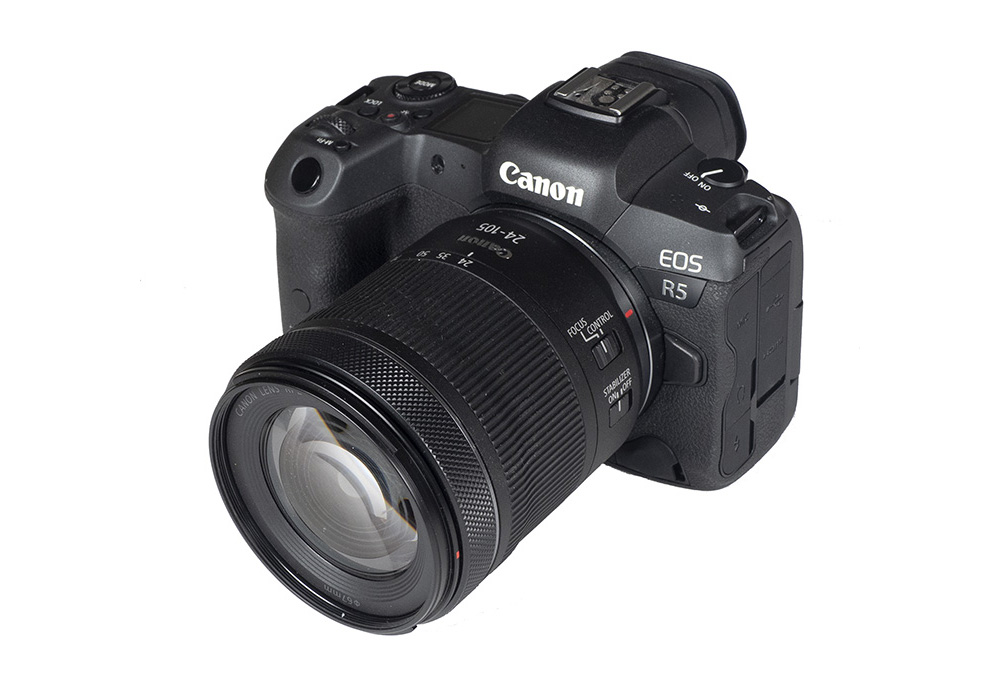Introduction
With full format mirrorless cameras replacing APS-C format, it is inevitable to see a rise in offerings of entry-level lenses. As so often, market leader Sony was the first with a full-format “kit zoom” lens (Sony FE 28-70mm f/3.5-5.6 OSS) for mirrorless cameras. However, alongside the release of the EOS RP, Canon finally countered this with its own Canon RF 24-105mm f/4-7.1 STM IS. At the time of the announcement, the lens was greeted with some skepticism due to its very slow max aperture of f/7.1 at 105mm. And yes, it’s a bit debatable whether having the slowest lenses of the industry (alongside the RF 100-500mm f/4.5-7.1 USM L IS and the RF 600/800mm f/11 STM IS) is something to be proud of. That being said – when looking at the “equivalent” apertures for APS-C and MFT lenses, it’s starting to make more sense if you have the intention of grabbing market share from these competing systems. The RF 24-105mm f/4-7.1 STM IS is typically sold with budget FF cameras but it’s also available separately. It’s priced around 400 USD/EUR which is typical in this lens class. When purchased as part of a camera kit, it’s usually a bit cheaper still.
The chassis has a fairly nice, non-slippery texture to it. It seems to be some compound material similar to what is also used in higher-priced Canon RF lenses. There’s a metal mount but no weather sealing. Like almost all standard zoom lenses, it extends when zooming towards longer focal lengths. The inner lens tube is a bit wobbly but not terribly so. The broad, rubberized zoom ring operates quite smoothly. The ring at the front serves two purposes – a focus mode and the typical, customizable R-mount control mode. An annoying aspect is the missing AF/MF switch. If you want to switch between focus modes, you will have to do so via the camera menu. Conversely, there is still a dedicated switch for the image stabilizer which is rated at an efficiency of up to 5 f-stops. A petal-shaped lens hood is optional.

As the name implies, the Canon RF 24-105mm f/4-7.1 STM IS uses a stepping motor (STM) for auto-focusing. It is normally quite fast and near noiseless. However, spot AF is quite useless – the camera barely finds its focus (using the EOS R5). It seems spot AF is quite a weakness on Canon mirrorless cameras in general – we had similar issues with the RF 100-500mm f/4.5-7.1 USM L IS on the original EOS R. Manual focusing works “by wire” which is perfectly fine. An interesting feature of the lens is its capability to focus down to a max magnification of 1:2. That’s basically macro territory although you shouldn’t expect the quality of a dedicated macro lens. This is possible in manual focus mode only with a minimum focus distance of 13cm at 24mm. Using AF you can still achieve a max magnification of 1:2.5 at 105mm.
| Specifications | |
|---|---|
| Optical construction | 13 sheets in 11 groups inc. 1x aspherical element |
| Number of aperture blades | 7 (rounded) |
| min. focus distance | 0.13m (max. object magnification AF 1:2.5x (@105 mm), MF 1:2x (@24 mm) |
| Dimensions | 76.6×88.8mm |
| Weight | 395g |
| Filter size | 67mm |
| Hood | barrel-shaped, bayonet mount, optical |
| Other features | image stabilizer, control ring |
Distortion
Let’s start with the image distortions … one of a couple of sad chapters to follow …
The RAW distortion characteristic of the Canon RF 24-105mm f/4-7.1 STM IS is rather dismal at 24mm. A barrel distortion of ~6.2% is simply extreme. Surprisingly, the situation is completely different at longer focal lengths with negligible distortions from 40mm to 105mm.


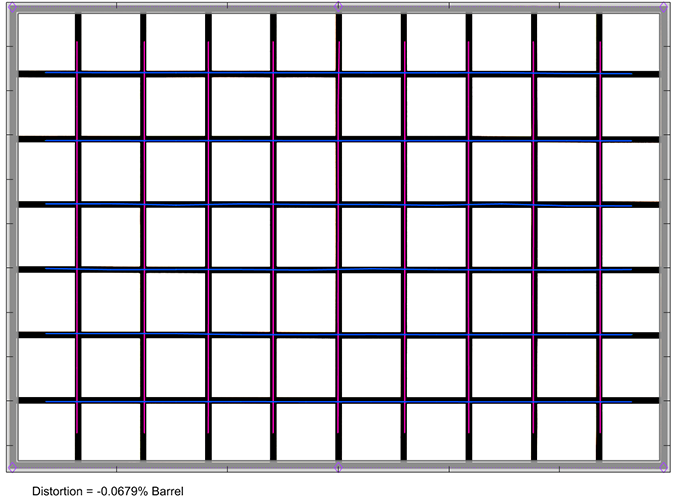

However, activated distortion correction can still fix the issue at 24mm as you can see below.
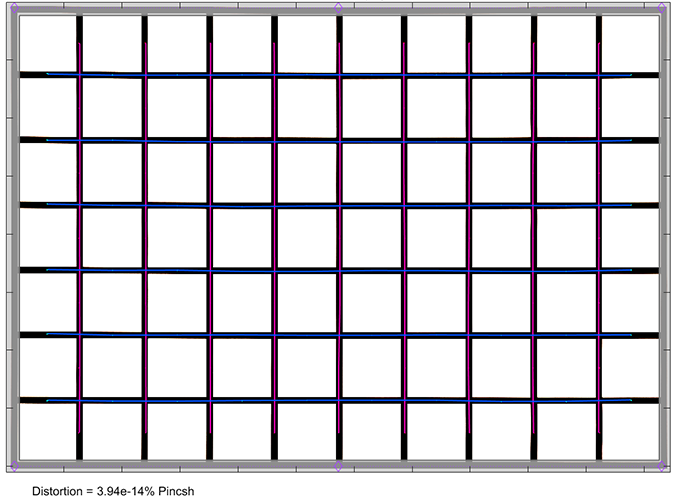
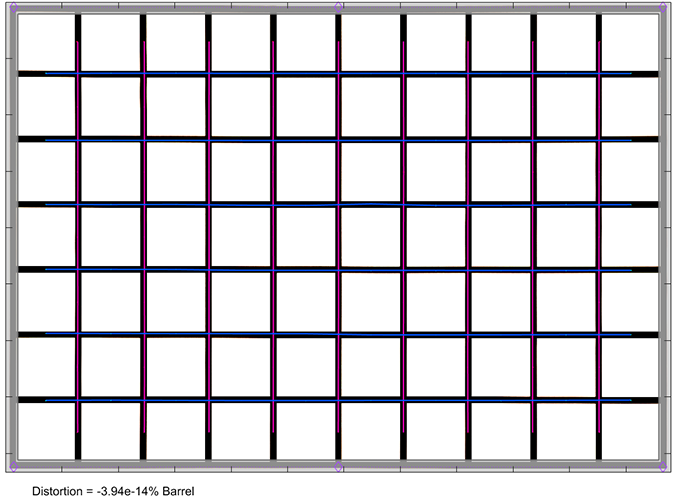


Vignetting
The fun at 24mm continues with respect to vignetting. Without auto-correction (that is also without distortion correction), the corners are just … black. Which is a bit of a shocker.

Here’s what it looks like:

However, in all fairness, Canon doesn’t even allow disabling distortion correction for in-camera JPEGs. If we follow this guidance, the results are actually more “normal”. There’s still some very heavy vignetting at 24mm at f/4 but one stop down, it’s quite acceptable actually.

With full auto-correction, vignetting is nothing to worry about – except for the increased corner noise due to the required signal boost.

MTF (resolution)
Our MTF analysis is usually based on uncorrected RAW images. This is fine unless you have to deal with excessive image distortions … more on this in the next chapter.
The Canon RF 24-105mm f/4-7.1 STM IS performs better than expected in our conventional test. While the figures aren’t brilliant, they are actually fairly decent for such an affordable standard zoom lens with an expected weak spot at the 24mm setting again. The broader center resolution is generally very good to excellent whereas the borders are taking a hit. At “large apertures” they are still good whereas the corners are soft. Stopping down to f/8 produces the best results with acceptable corners. Longer focal lengths perform surprisingly well with no real weakness (nor strength).
The field curvature is very low. The centering quality of the tested sample was Ok.
Please note that the MTF results are not directly comparable across the different systems!
Below is a simplified summary of the formal findings. The chart shows line widths per picture height (LW/PH) which can be taken as a measure for sharpness. If you want to know more about the MTF50 figures, you may check out the corresponding Imatest Explanations

While the above is looking Ok, there is the mentioned caveat – the excessive distortion at 24mm. You will not use RAW images taken with this lens at 24mm and the distortion correction doesn’t come free of charge. The price you pay is the stretching of the image and that’s mostly done in the outer image field where the impact is worst. The MTF below shows the resolution with activated auto-correction. As you can see the broader center remains mostly intact with a negligible decrease in quality. The borders are soft and the corner quality is basically … gone.
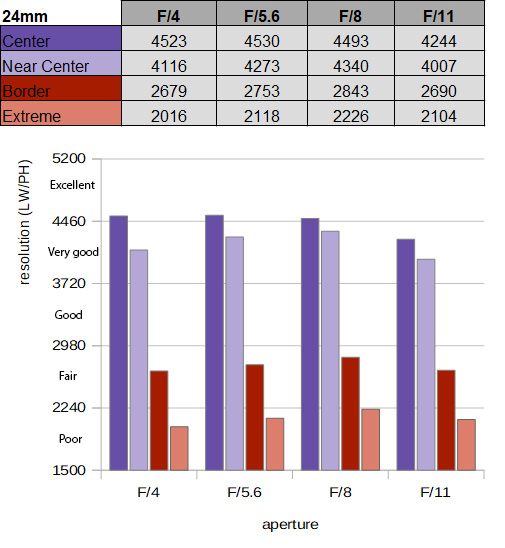
However, things are still not as obvious as they may seem. The above results are based on the R5 – thus on a 45mp sensor. If you purchased an R5 with this lens, you are nuts. In real life, this lens is used on entry to mid-level cameras with a resolution between 20-30mp. And this is putting much less stress on the lens quality. At 20mp (e.g. the EOS R6) you could mount a coke bottle and the results would still be mostly Ok (sort of). Below are the MTFs (auto-corrected) based on the 30mp sensor of the original EOS R. So as you can see, the results aren’t QUITE as embarrassing as they are on the EOS R5. Even the corners are still fairly good. Longer focal lengths are perfectly fine on lower resolution cameras anyway.
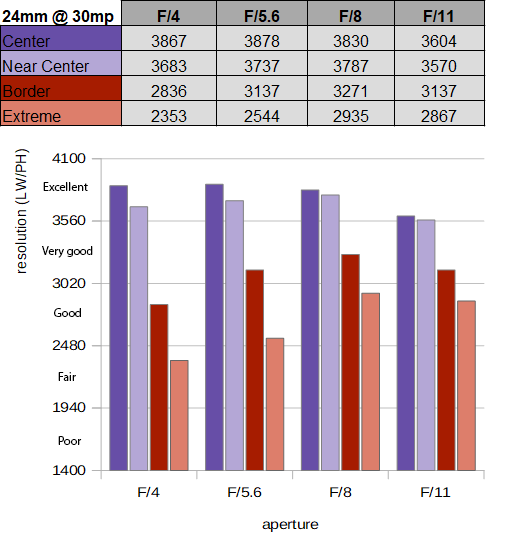
Chromatic Aberrations (CAs)
Lateral CAs (color shadows at the image borders) are about average and visible without auto-correction. They reach their peak at 40mm f/5 with an average pixel of ~2.6px at the image borders. Stopped own and at other focal lengths, they are relatively decent though.

Bokeh
Let’s have a brief look at the bokeh. Just to point out the obvious – if you buy this lens with the intention of achieving a shallow depth-of-field, you are doing it wrong. We are talking about a lens with a max aperture of f/7.1 at 105mm after all. Of course, you can still produce some out-of-focus blur when using close focus distances but the lens is certainly not made for this purpose.
That being said, the rendering of out-focus-highlights is actually good with a pretty clean inner zone of the discs. They are also maintaining a circular shape in the image center even when stopped down to f/11.

When looking at out-of-focus highlights across the image frame, things are also surprisingly fine. The circular shape is maintained across a broad part of the image field.
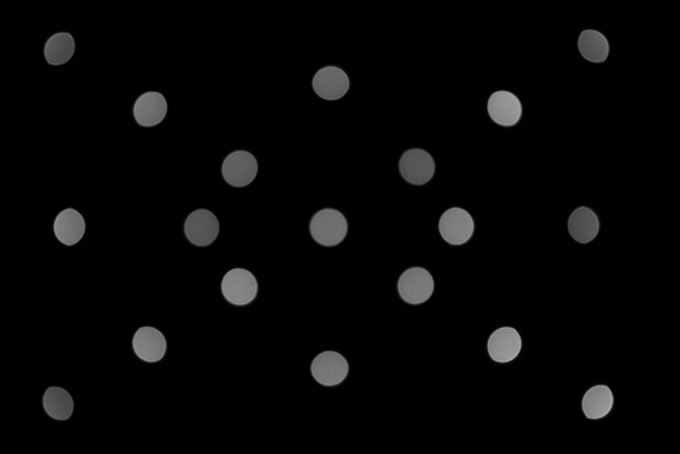


Sample Images
A verdict on the Canon RF 24-105mm f/4-7.1 STM IS has to be a bit more varied than usual.
In absolute terms, it's clearly a sub-standard lens. Its native characteristics range from good to downright terrible. The miserable vignetting and distortions have to be seen to be believed. Conversely, the resolution is actually pretty decent - which is a bit of a pity because you just won't use this lens without auto-correction.
Most users will have auto-correction activated anyway but this doesn't fix everything. Yes, the distortions are gone and the vignetting is easily acceptable. Lateral CAs are not an issue in this case as well, of course. However, the distortion correction is killing the corner resolution at 24mm. On a high megapixel camera, the corners are a pixel soup at 24mm even stopped down. The quality is surprisingly high at longer focal lengths though.
That being said - it is highly unlikely that you invest thousands into a high-megapixel camera and then just a few hundred on a cheap kit zoom lens. The pixel-level sharpness increases towards lower sensor resolutions and the vast majority of users have cameras featuring 20 to 30 megapixels (as of the time of this review). Within this context, the Canon RF 24-105mm f/4-7.1 STM IS makes much more sense. The 24mm setting will still not be perfect here but it's certainly usable.
However, it's still worth pointing out that this lens is underdesigned. If you allow for zooming any lens below its designed minimum focal length, you will end up with black corners because the image circle has reached its limits. And this is what happened here. This is actually not a 24-105mm lens but more like a 28-105mm. Probably few would have complained if Canon marketed it like that - and our final rating would have been substantially higher.Coming back to the less philosophical thoughts - the mechanical quality of the lens is pretty good for a kit zoom lens. The used materials are of high quality. The (extending-)inner lens tube is a bit wobbly though and this seems to be a theme across Canon consumer-grade Canon lenses. The construction is also a bit simplified with its combined focus/control ring. However, that's perfectly fine within the scope of this lens. The STM AF is pretty quick (if you avoid spot AF) and the image stabilizer does a decent job. This is also needed regarding the very slow-speed nature of the lens.
Of course, everything in life is a compromise, and the RF 24-105mm f/4-7.1 STM IS is all about making it possible to a budget. However, if you can stretch it, you'd really be better off with the Canon RF 24-105mm f/4 USM L IS. While more expensive, it's just a better investment.
-
Optical Quality
-
Build Quality
-
Price / Performance


